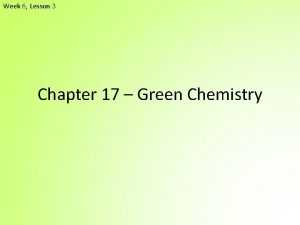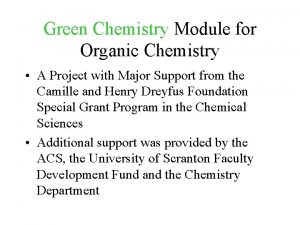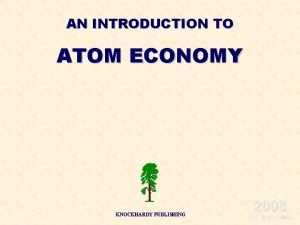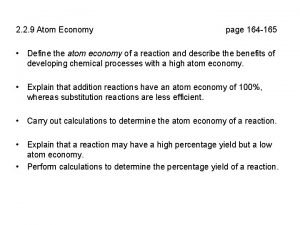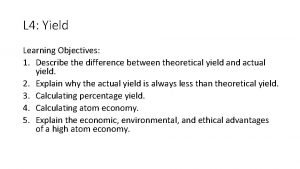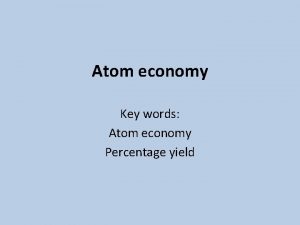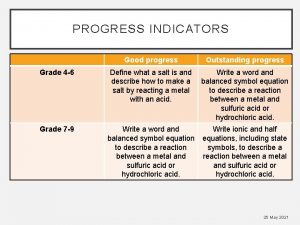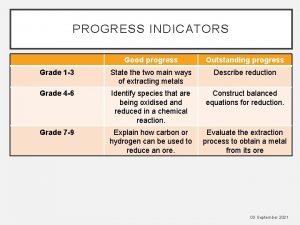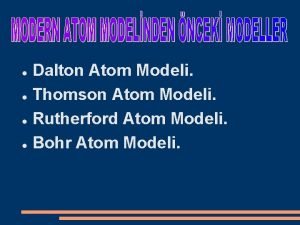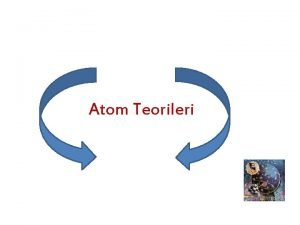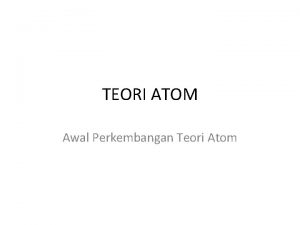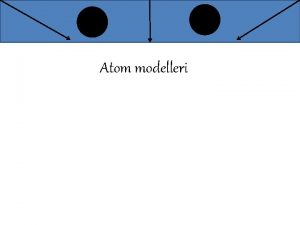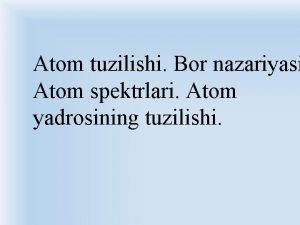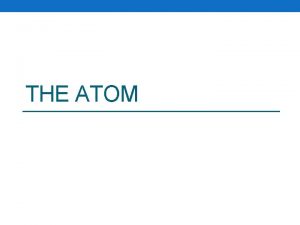Atom Economy DNA Progress indicators Good progress State





















- Slides: 21

Atom Economy DNA:


Progress indicators Good progress: - State what is meant by atom economy - Calculate the atom economy of a reaction Outstanding progress: -Explain why atom economy is important to industrial processes

Task: Watch the video and answer the following question: https: //www. youtube. com/watch? v=Zuyk 4 hfbj. SA 1. What is atom economy? 2. What is the calculation for atom economy? 3. What would the atom economy be for a reaction where only one product forms. 4. What is the atom economy for the second example question? 5. Why is it important that industries work towards the most efficient industrial processes? 6. Efficient processes conserve more ________ and produce ________.

Self-assessment: 1. Atom economy tell us the amount of product that was useful as a percentage of all the products formed. 2. Percentage atom economy = x 100% 3. The atom economy would be 100% if only one product formed. 4. Atom economy for the second example question would be 29. 5% 5. It is important to ensure high atom economy as this ensures sustainable development. 6. Efficient processes conserve more natural resources and produce less waste.

Worked example: The following shows a reaction for making hydrogen from methane: CH 4 + H 2 O CO + 3 H 2 Calculate the atom economy for making hydrogen in this reaction Remember: • The first thing to figure out is what is the desired product? • Next, calculate the Mr of the desired product and of each of the reactants (for this calculation you multiply the M r by the no. of moles) • Then, calculate the atom economy using the equation

CH 4 + H 2 O CO + 3 H 2 • The desired product is hydrogen • Mr of desired product = 2, multiplied by number of moles =2 x 3=6 • Mr of reactants = - CH 4 = 12 + (4 x 1) = 16 - H 2 O = (1 x 2) + 16 = 18 - Total = 16 + 18 = 34 • Atom economy = 6 / 34 = 0. 18 x 100 = 18%

Task: Using the worked example, write down a step-by-step checklist of tasks you will need to complete in order to calculate atom economy of a reaction

To work you atom economy you must: 1. Write out the balanced symbol equation if it has not been provided for you 2. Decide what the desired product is 3. Calculate the Mr of the desired product 4. Calculate the Mr of each of the reactants 5. Add together so that you have the total Mr of all of the reactants 6. Calculate the atom economy by dividing the relative formula mass of the desired product by the sum of the relative formula mass of the reactants, then multiplying by 100%.

Task: Complete the questions on atom economy

Self-assessment: 1. What is the atom economy of extracting iron from its ore? Fe 2 O 2 + 3 CO 2 Fe + 3 CO 2 1. Desired product: Fe 2. Mr of 2 Fe = 56 x 2 = 112 3. Mr of reactants: - Fe 2 O 2 = 144 - 3 CO = 84 - Total = 144 + 84 = 228 4. Atom economy = 112 / 228 x 100 = 0. 49 x 100 = 49%

2. Calculate the atom economy for the production of copper sulphate: Cu. O + H 2 SO 4 Cu. SO 4 + H 2 O 1. Desired product: Cu. SO 4 2. Mr of Cu. SO 4: 160 3. Mr of reactants: - Cu. O = 80 - H 2 SO 4 = 98 - Total = 80 = 98 = 178 4. Atom economy = 160 / 178 x 100 = 0. 90 x 100 = 90%

3. Calculate the atom economy for the production of ammonia from thermal decomposition of ammonium sulphate: (NH 4)2 SO 4 H 2 SO 4 + 2 NH 3 1. Desired product: H 2 SO 4 2. Mr of H 2 SO 4 : 98 3. Mr of reactants: - (NH 4)2 SO 4 = 132 4. Atom economy = 98 / 132 x 100 = 0. 74 x 100 = 74%

4. Calculate the atom economy for thermal decomposition of calcium carbonate 1. Write out the balanced symbol equation – Ca. CO 3 Ca. O + CO 2 2. Desired product: Ca. O 3. Mr of desired product 56 4. Mr of reactants: - Ca. CO 3 = 100 5. Atom economy = 56 / 100 x 100 = 0. 56 x 100 = 56%

5. Calculate the atom economy for the production of magnesium chloride during the reaction between magnesium and hydrochloric acid. 1. Write out the balanced symbol equation – Mg + 2 HCl Mg. Cl 2 + H 2 2. Desired product: Mg. Cl 2 3. Mr of desired product: 95 4. Mr of reactants: - Mg = 24 - 2 HCl = 36. 5 x 2 = 73 - Total = 97 5. Atom economy = 95 / 97 x 100 = 0. 98 x 100 = 98%

6. Sodium nitrate decomposes on heating to produce sodium nitrite and oxygen gas. What is the atom economy of this reaction? 1. Write out the balanced symbol equation: Na. NO 3 Na. NO 2 + O 2 2. Desired product: Na. NO 2 3. Mr of desired product: 69 4. Mr of reactants: - Na. NO 3 = 85 5. Atom economy = 69 / 85 = 0. 81 x 100 = 81%

Exam-style question Titanium can be extracted from its ore by two different methods. One uses a more reactive metal to displace the titanium: Ti. O 2 + 2 Mg → Ti + 2 Mg. O The second method is electrolysis of the ore. The overall reaction for this method is: Ti. O 2 → Ti + O 2 a) Calculate the atom economy for each reaction. (4) b) Which method could be described as more sustainable? Explain your answer. (2) c) Oxygen is a useful product and can be sold. What is the atom economy of the electrolysis if the oxygen is collected and sold? (2)

Mark Scheme a) First reaction Mr of desired product: 48 Mr of reactants: - Ti. O 2 = 80 - 2 Mg = 48 - Total = 128 Atom economy = 48/128 = 0. 375 x 100 = 37. 5% Second reaction Mr of desired product: 48 Mr of reactants: - Ti. O 2 = 80 Atom economy = 48/80 = 0. 6 x 100 = 60% (4) b) The second reaction has a higher atom economy which means that the chemical reaction produces less waste which means that the process is more sustainable as it will conserve more natural resources and also save the industry more money. (2) c) Mr of oxygen = 32 Mr of reactants = Ti. O 2 = 80 Atom economy = 32 / 80 = 0. 40 x 100 = 40% Atom economy of titanium = 60%, therefore 40% + 60% = overall 100% (2)

Task: Come up with 5 exam-style questions on the topic of atom economy. Make sure you include a range of questions and provide a mark scheme for each one.

Plenary ~ Complete one of the following sentences in your book: One thing I must remember from today’s lesson is… Before this lesson I already knew how to … Today I have learnt that … I still don’t understand ….

 Athens and sparta were both
Athens and sparta were both Physical progress and financial progress
Physical progress and financial progress Atom economy in green chemistry
Atom economy in green chemistry Green chemistry
Green chemistry Atom economy formula
Atom economy formula Atom economy vs percent yield
Atom economy vs percent yield Thermal decomposition of calcium carbonate
Thermal decomposition of calcium carbonate Knockhardy
Knockhardy Calculating atom economy
Calculating atom economy Atom economy
Atom economy Atom economy
Atom economy Good thoughts, good words, good deeds meaning
Good thoughts, good words, good deeds meaning Hello hi good morning
Hello hi good morning Good afternoon buenas tardes
Good afternoon buenas tardes You are good you are good when theres nothing good in me
You are good you are good when theres nothing good in me Hello teacher good afternoon
Hello teacher good afternoon Transition bugs in software testing
Transition bugs in software testing The structure of the atom section 2 defining the atom
The structure of the atom section 2 defining the atom Thomson atomic
Thomson atomic Replication fork
Replication fork Bioflix activity dna replication lagging strand synthesis
Bioflix activity dna replication lagging strand synthesis Coding dna and non coding dna
Coding dna and non coding dna


